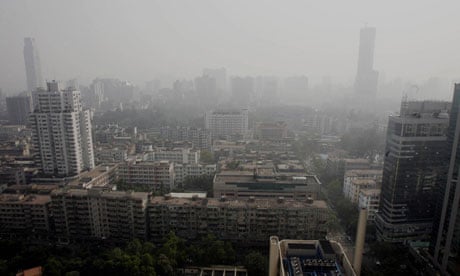China has not measured data on the most dangerous types of air pollution because it is afraid of the political consequences, according to US diplomatic cables.
This assessment, which comes to light as the government prepares to upgrade its air quality monitoring system, was among the central findings of cables from the US consulate in Guangzhou that were relased on Wednesday by WikiLeaks.
Diplomats based in the industrial heartland of Guangdong – known as the workshop of the world and also one of the worst areas for acid rain and other pollution – looked in detail at monitoring systems and health impacts in 2006.
Based on research by local scientists, the consulate noted in a cable dated 16 August that small-particulate matter known as PM2.5, was five to 10 times higher than suggested by World Health Organisation guidelines.
It said the findings were "alarming", because PM2.5 is not on the government index of air pollutants yet it is deemed to be of highest concern for public health because the particles are so fine they can enter into the lungs, contribute to acute respiratory symptoms, heart disease, childhood illnesses and premature deaths.
The diplomats observed, however, that this form of pollution was not being systematically measured and made public because the findings were likely to be too sensitive for the authorities.
"Those lobbying for its inclusion in an index of pollutants conceded that including a pollutant whose current levels would measure so far above acceptable standards would be politically difficult," the cable said.
Problems about transparency extended to academia, according to another cable dated 19 September 2006, which describes: "Academics and research scientists in Guangdong, who are increasingly concerned about the region's serious air pollution, but feel pressured to tone down their comments lest they face cuts in research funding ... Scientists acknowledge that lack of transparency for existing air pollution data is a major problem both for research and policy making."
Diplomats who attempted to research the possible links between pollution and birth defects were denied meeting requests on the grounds that the subject was "too sensitive".
PM2.5 was not the only problem. Until now, Ozone – another dangerous pollutant – has also been omitted from the index, When the US Environmental Protection Agency Assistant Administrator for Air and Radiation William Wehrum visited the Guangdong Environmental Information Center in 2006, a member of his delegation noted: "The raw data on the LCD screen showed extremely high levels of O3 (Ozone)".
Since the cable was written in November 2006, however, environmentalists have commended the progress that China has made in measuring, disclosing and reducing air pollution, but many of these concern remain today.
The state media reported on Thursday that a new index would soon be introduced. Expectations are high that it will include ozone for the first time. Less certain is whether PM2.5 will finally be added.
